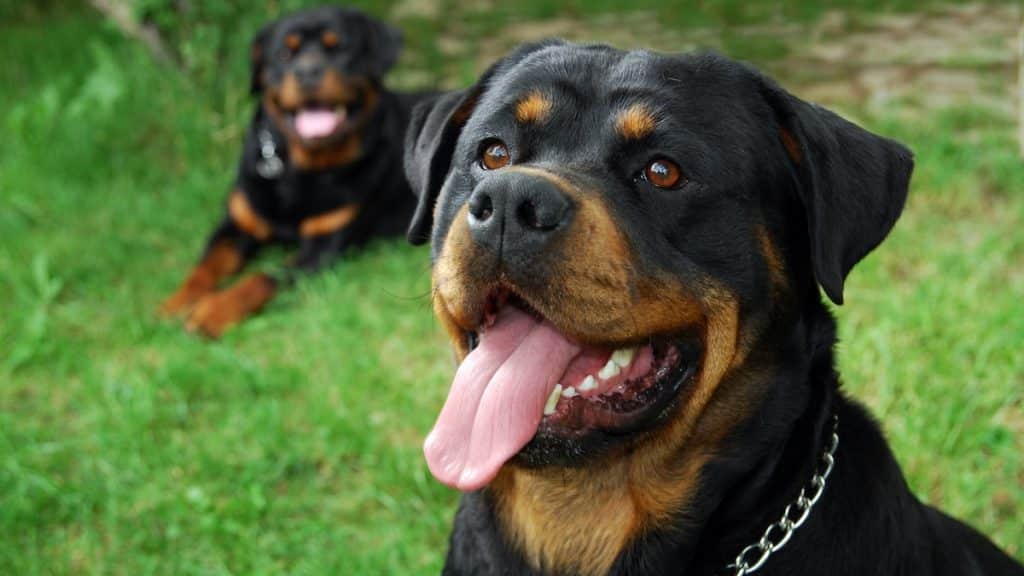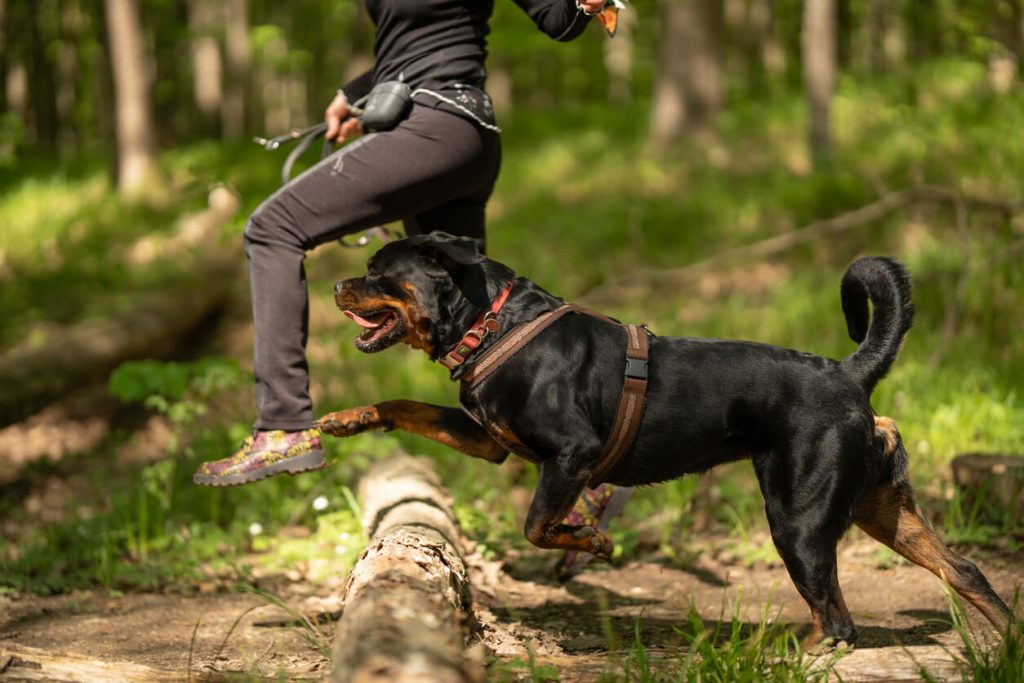
The Rottweiler (pronounced rott-wy-lur) is a powerful and intelligent breed known for its loyalty, confidence, and quiet devotion to family. Often seen as natural protectors, these dogs are affectionate team players at heart, happiest when working alongside their people and keeping a watchful eye on their home.
With the right training and early socialization, Rottweilers make steady, loving companions who thrive in active households. Their intelligence and eagerness to work make them a favorite in roles like obedience, protection, and police work.
“They thrive in structured homes where they can be part of the team, both physically and emotionally,” says Jill Miller, member of The American Rottweiler Club.
Curious if the Rottweiler fits your lifestyle? Keep reading to learn more about their history, care needs, and what it’s really like to share your life with this strong and loyal breed.
Key Breed Characteristics & Facts
Few breeds balance strength and sensitivity quite like the Rottweiler. Known for their broad chests, blocky heads, and intense gaze, these dogs might look intimidating at first, but they’re often affectionate, eager to please, and deeply bonded with their people.
Adult Rottweilers typically stand 22 to 27 inches tall at the shoulder, with females on the shorter end of the range and males on the taller end.
Females usually weigh between 80 and 100 pounds, while males can range from 95 to 135 pounds.
Rottweilers belong to the AKC’s Working Group, since they were originally bred to herd cattle and pull carts for butchers and farmers.
Rottweilers are almost always black with clearly defined rust or mahogany markings on their cheeks, chest, legs, and above the eyes.
These pups have a short double coat that sheds year-round, with heavier seasonal shedding in the spring and fall.
Rottweilers are active dogs that are bred to work, so they need daily physical and mental stimulation to stay happy and well-behaved.
Rottweilers aren’t excessive barkers, but they do make a variety of vocalizations, like the signature “Rottie rumble,” to communicate with their family.
Rottweilers are affectionate with family but may be aloof or wary around strangers without proper socialization to people.
Rottweilers typically live 9-10 years, though some can live longer with good care and regular veterinary attention.
Common issues include hip and elbow dysplasia, heart disease, cancer, and certain eye and joint conditions. Responsible breeding and regular checkups can reduce risk.
Rottweilers are large, heavy-set dogs with substantial muscle mass, particularly in their chest and shoulders.
Rottweilers are typically calm and self-assured around their families but may be cautious with new people or pets. Early socialization helps them develop into well-mannered, confident companions.
Physical Characteristics
Rottweilers have a strong, athletic build with a broad chest, thick neck, and muscular frame that gives them a powerful, grounded appearance. A Rottie’s head is broad and blocky, with a straight, strong muzzle and a confident expression. Their medium-sized ears are triangular and lie flat against the head, and their tails may be naturally long or docked, depending on the breeder and country.
The breed has a short, dense double coat that feels coarse to the touch and sheds moderately throughout the year. Rottweilers are best known for their classic black coats with well-defined rust or mahogany markings on the cheeks, chest, legs, and eyebrows.
Breed History
Rottweilers have been excelling as working dogs since the Roman Empire. Given their long history as livestock guardians, herding dogs, watchdogs, and cart pullers, it comes as no surprise that these pups show up today in police work, personal protection, and search-and-rescue.
The breed took its modern form in 1914, when enthusiasts established the first Rottweiler club, the Deutscher Rottweiler-Klub (DRK). This club was followed by the formation of the Allgemeiner Deutscher Rottweiler Klub (ADRK) in 1921 and the American Rottweiler Club (ARC) in 1973.
The Rottweiler’s roots go all the way back to the Roman Empire, where their ancestors helped herd and guard livestock that fed the traveling legions. These early dogs were strong, durable, and focused, which are traits that remain deeply embedded in the breed today.
After the fall of the Roman Empire, the drover dogs settled in the cattle town of Rottweil. There, they became essential to local butchers, helping move cattle to market, pull meat carts, and guard goods and money on the journey home. Over time, the “Rottweiler Metzgerhund,” or Butcher’s Dog of Rottweil, earned a reputation for being strong, reliable, and protective without being overly friendly to strangers.

Temperament & Personality
Rottweilers are focused, self-assured dogs who like to stay involved in whatever their people are doing. As people lovers, they form strong attachments to their families and are known for being attentive, affectionate companions who thrive on routine. With the people they trust, Rottweilers often show a warm, playful side and can be surprisingly goofy around the house.
Because they were bred to work closely with humans, Rottweilers do best when they have a job to do, whether it’s structured training, obedience practice, or simply following a daily routine. They’re smart, capable problem-solvers, and they can become a challenge if they’re left to entertain themselves.
Without thorough socialization and physical and mental enrichment, some Rottweilers may develop issues like destructiveness, reactivity, or becoming overly territorial. As with any breed, temperament can vary from dog to dog, so it’s important to treat each Rottweiler as an individual.
Health & Lifespan
Rottweilers typically live 9 to 10 years. As a large, deep-chested breed, their primary health risks are orthopedic problems, heart disease, and certain cancers. Regular veterinary checkups at least once a year can help catch issues early, and weight management and daily exercise reduce risks.
These joint conditions can cause pain, stiffness, and difficulty moving. Look for signs like limping, reluctance to stand, or stiffness after rest. Preventative care includes weight management, joint supplements, and low-impact exercise.
Rottweilers have an elevated risk of developing certain cancers, including bone cancer and lymphoma. Watch for symptoms like unexplained swelling, lameness, weight loss, or changes in appetite. Early detection and regular checkups are key.
Rottweilers are prone to heart issues such as subaortic stenosis (SAS) and cardiomyopathy. Signs can include fatigue, shortness of breath, or fainting. Early screening, especially in young adults, and routine monitoring can help manage these risks.
Bloat is a life-threatening condition that can affect large, deep-chested dogs like Rottweilers. Signs include restlessness, drooling, and a swollen abdomen. Feeding smaller, more frequent meals and avoiding exercise right after eating may help reduce the risk. You can also ask your vet about preventative surgery (gastropexy) during spay/neuter.
Care & Maintenance
Rottweilers are medium- to high-maintenance dogs, because they require consistent structure, exercise, and engagement to thrive. They do best in homes where they’re part of the daily routine and treated as active companions. A Rottweiler without a job will often invent one, and that can lead to problem behaviors. With the right care, though, they’re deeply rewarding dogs who love to work, play, and be part of the family.
Their short double coat requires weekly brushing, with heavier shedding during seasonal coat blows. Nail trimming can be tricky due to dark nails, so consider using a nail grinder instead of clippers, and make sure to introduce a Rottweiler puppy to paw handling very early so they get used to the sensation.
This is a working breed with a lot of energy. Therefore, Rotties need 1 to 2 hours of daily exercise, including walks, play, and dog sports like cart or sled pulling or obedience trials.
Rottweilers are smart and eager to learn, but they’re also strong-willed. They respond best to calm, consistent, positive reinforcement training. Without guidance, they may become pushy, mouthy, or overly protective.
Rotties need a job, like daily training, puzzle toys, obedience training, or scent games. Without stimulation, they may become destructive or anxious.
This breed is prone to obesity and joint issues, so weight management is key. Feed high-quality food in measured portions, and avoid excessive treats. Speak with your vet about joint supplements or large-breed formulas.
Ideal Living Environment & Compatibility
Rottweilers thrive best in homes where they receive plenty of daily exercise, mental stimulation, and close companionship. They’re highly social dogs who need consistent exposure to people and other animals to develop confidence.
Because of their strength and intelligence, they benefit most from experienced owners who can provide firm, positive leadership. As a devoted breed, they want to be included in family activities, whether that’s hiking, car rides, or playing games in the yard.
Rottweilers do well in temperate climates but can struggle with extreme heat or cold. Very hot or humid places require extra care to avoid overheating.
They can live in apartments if given plenty of exercise, but a fenced yard is ideal for off-leash play and mental stimulation. They are not suited to being outside-only dogs and prefer to be near their people throughout the day.
Running, hiking, swimming, obedience training, and interactive play keep Rottweilers physically and mentally engaged. They are also compatible with many sports, especially weight pulling and canicross.
Rottweilers are affectionate with family but cautious around strangers. Early socialization helps manage their natural protectiveness and encourages balanced behavior.
Rottweilers do well with children when families raise them together and provide proper supervision due to the breed’s size. They can get along with other pets if socialized early but may show guarding tendencies. Most experts don’t recommend this breed for first-time dog owners because of their strength and training needs.
Is the Rottweiler a Good Fit for You?
Rottweilers are strong, smart, and deeply attached to their humans. If you’re looking for a dog with heart, humor, and a serious work ethic, a Rottie might just be your perfect match.
To learn more about welcoming a Rottweiler into your home, explore our Rottweiler puppy guide or The American Rottweiler Club’s website. And for a real-life look at Rottie personality, check out @jerrythefamousrottie, one of Instagram’s most beloved Rottweilers.
Resources
- About Rottweilers. (n.d.). https://www.amrottclub.org/about-the-rottweiler/
- Miller, J. (2025). Personal interview.
- Rottweiler. (n.d.) https://www.britannica.com/animal/Rottweiler